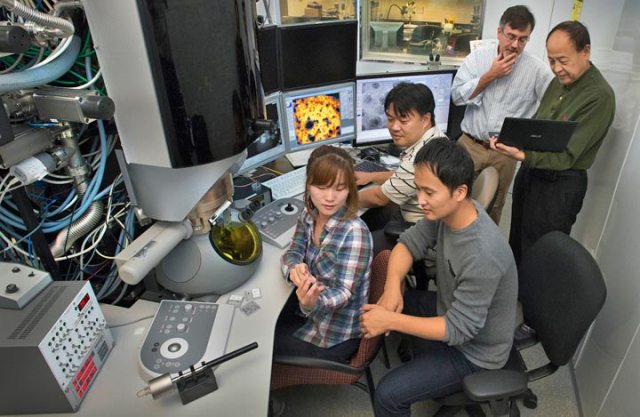
Scientists in the electron microscopy lab of Brookhaven Lab's Center for Functional Nanomaterials.
Researchers at Brookhaven National Laboratory have performed three studies on the electrochemical reactions that occur in nickel, cobalt, and aluminum (NCA) lithium-ion batteries. They studied average material morphologies as well as atomic-scale asymmetries to analyze the electronic and structural degradation of these batteries.
Lithium-ion batteries play an important role in rechargeable electric vehicles. However, with every charge and discharge cycle, they degrade. During the battery cycle, lithium ions move between the anode and cathode within the battery, and detectable nanoscale damage occurs.
In addition, the high temperatures generated during operation exacerbate this damage further. Better understanding of thermal runaway and structural changes will help improve NCA batteries.
In the first study, the researchers used spectroscopy and x-ray diffraction. They bombarded the material using high-frequency photons to study elemental composition and structure. The effects that occurred due to increasing heat were observed in real time. A fully charged NCA coin-cell battery was heated to 500°C, to push it out of thermal equilibrium.
This caused the uniform crystalline atomic structure of the material to transform into a disordered rock-salt configuration. Oxygen escaped during this process, which contributes to the risk of flammability. The results from this study suggest that operating the battery at full energy capacity speeds up the degradation.
The researchers used transmission electron microscopy in the second study to find out the effect that the initial charge had on the surface structure of the battery. The batteries were energized into an overcharged state and the electron beams exposed the individual atom positions. Changes in crystallinity were observed with each charge and this was found to be worse when the charge level was increased.
Electron energy loss spectroscopy revealed elemental configurations and charge densities. Electron density of oxygen increased while nickel decreased during this process. This made the oxygen escape, leading to holes on the surface of the NCA and affected the battery’s performance.
In the third study, the heat-driven decomposition that occured in the NCA materials at various charge states were tracked using in situ electron microscopy. Charging was found to cause decomposition and vulnerabilities even in stable NCA samples at 400°C. However, in fully charged condition, oxygen was released by some particles.
Disorder began to shift downwards to temperatures below 100°C. This study reveals that degraded, unstable particles could activate thermal runaway reaction at lower temperatures. Further the oxygen would fuel the fire due to an overheated battery.
This study suggests usage of nanoscale coatings and other methods to improve the durability of NCA batteries.